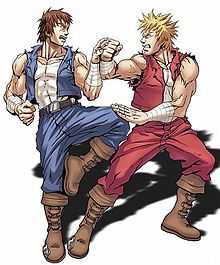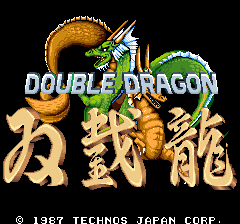Double Dragon (series)
| Double Dragon | |
|---|---|
|
The title screen of the 1987 arcade game | |
| Genres | Beat-'em-up |
| Developers | Technōs Japan (currently Million) |
| Publishers | Technōs Japan (currently Million) |
| Platforms | Arcade, Nintendo Entertainment System, Master System, Master System, Atari 2600, Atari 7800, Game Boy, Mega Drive/Genesis, Lynx, Game Gear, Super Nintendo Entertainment System, Jaguar, Neo Geo, Neo Geo CD, PlayStation, PlayStation 3 (PlayStation Network), Game Boy Advance, Xbox 360 (Xbox Live Arcade), iOS |
| Platform of origin | Arcade |
| First release |
Double Dragon 1987 |
Double Dragon (ダブルドラゴン) is a beat 'em up video game series initially developed by Technōs Japan, who also developed the Kunio-kun series (Renegade, Super Dodge Ball and River City Ransom).
The series stars twin brothers, Billy and Jimmy Lee, who are followers of a fictional martial art called Sōsetsuken (双截拳), as they fight against various adversaries and rivals. Due to the popularity of the game series, an animated series and live-action film adaptation have also been produced.[1]
Titles
The original Double Dragon by Technōs was first released as a coin-operated arcade game in 1987. A Nintendo Entertainment System version also produced by Technōs was released the following year, followed by a Game Boy version in 1990. Various licensed versions of the games were also produced by other developers for various gaming platforms such as the Master System, Atari 2600, Atari 7800, Genesis, and the Lynx. Versions of Double Dragon for home computers were also released as well. A Game Gear game titled Double Dragon also exists, but it is not another port of the original game. It is based on Streets of Rage instead, especially the main character, Billy Lee, who strongly resembles Axel Stone, the protagonist of Streets of Rage series.
Two Double Dragon sequels were released for the arcade: Double Dragon II: The Revenge in 1988 and Double Dragon 3: The Rosetta Stone in 1990. Like the original, Technōs produced versions for the NES in 1989 and 1991 respectively. A fourth game was released exclusively for the Super NES in 1992, titled Super Double Dragon. It was the last game produced by the original team at Technōs, and the last to retain the beat-'em-up gameplay of the original.
In 1994, Tradewest released Double Dragon V: The Shadow Falls for the Super NES and Genesis in North America and Europe, a competitive fighting game developed by Leland Interactive based on the Double Dragon animated TV series by Bohbot Entertainment. A Jaguar version was released by Telegames as well.
Another fighting game was produced by Technōs, simply titled Double Dragon, was released for the Neo-Geo arcade and home console in 1995. A Neo-Geo CD version was also released, as well as a PlayStation version by Urban Plant. It was the last Double Dragon game produced by Technōs before the company went out of business.
In 2003, a remake of the original Double Dragon, titled Double Dragon Advance, was produced by Atlus and Million (the current copyrights holder of the Double Dragon series) for the Game Boy Advance.
In 2011, another remake was released for the iPhone, developed by Brizo Interactive and published by Aksys Games.
On April 4, 2012, WayForward Technologies announced that they would be developing Double Dragon Neon, a reboot of the series.[2] The game was released September 11, 2012 for PlayStation Network, one day later for Xbox Live, and will be released for PC in the first quarter of 2014.[3][4]
On April 5, 2013, Double Dragon II: Wander of the Dragons, a 3D remake of the original Double Dragon II, was released on the Xbox Live Arcade by game developer Gravity.[5]
Other appearances and related games
- Super Spike V'Ball (NES) - The NES version which features Billy and Jimmy as playable characters.
- WWF Superstars (arcade) - Features a cameo by Billy as one of the game's spectators.
- River City Ransom (NES) - The Double Dragon theme music plays during the battle against Randy and Andy, two characters based on Billy and Jimmy. The Japanese counterparts of Randy and Andy, Ryūichi and Ryūji, are recurring characters in the later Kunio-kun games.
- Battletoads & Double Dragon (NES, GB, Genesis, SNES) - A crossover game between Double Dragon and the Battletoads.
- Voltage Fighter Gowcaizer (Neo-Geo) - Burnov from the Neo-Geo Double Dragon game makes a cameo as Captain Atlantis' opponent in his ending.
- Rage of the Dragons (Neo-Geo) - An unofficial homage to the Double Dragon produced by Evoga and Noise Factory. The main characters are named Billy and Jimmy Lewis.
Related media
A Double Dragon comic book limited series loosely based on the games was published by Marvel Comics in 1991, which lasted six issues from July to December. The comic book was written by Dwayne McDuffie for the first four issues and by Tom Brevoort and Mike Kanterovich for the final two.
A Double Dragon animated series was produced by DiC Entertainment and Bohbot Productions, which originally aired in syndication for two seasons from 1993 to 1995, lasting 26 episodes.
A film version of Double Dragon was released in theaters in 1994 directed by James Yukich and starring Scott Wolf and Mark Dacascos as the Lee brothers.
In a season 3 episode of the American television sitcom Malcolm in the Middle titled Charity, after the boys are forced by their mother to do charity work for a local church Reese mentions a guy dropping off an old Nintendo system and Double Dragon 4. Then Stevie responds "DD4? The Sacred Stones?" which was in reality the name of DD3. The fourth game in the series was for the SNES and was called Super Double Dragon.[6]
Recurring elements

In most of the Double Dragon games, the player takes control of the martial artist Billy Lee (Player 1), or his twin brother Jimmy Lee (player 2), as they fight off against various gang members through the streets of a city and various other locations.
Their appearances have changed throughout the life of the series, usually swapping between hair color. Billy Lee originally having brunette hair and darker skin and Jimmy Lee having Blonde hair and lighter skin. As the series went on in some games Billy's hair was changed to Blonde and Jimmy's to Brunette. Such titles as "Super Double Dragon" the twins' hair styles has changed as well having Billy with a brunette laid down style and Jimmy with a blonde high-cut style. In Double Dragon 2: The Revenge, Jimmy wears a white outfit instead of his trademark red outfit.
The gameplay in most of the games takes place in a pseudo 3D perspective like in Renegade and later beat-'em-ups, in which the player character can move in four directions but are always facing left or right. The player can perform a variety of unarmed fighting techniques against their enemies, as well use melee weapons such as baseball bats and throwing knives normally obtained from enemies. In some installments, there are techniques that can be done in combination with another player.
According to the supplementary materials for some of the games, Billy and Jimmy Lee practice the fictional art of Sōsetsuken (双截拳, "Twin Intercepting Fists"), a nod to Bruce Lee's fighting method of Jeet Kune Do, meaning "Way of the Intercepting Fist". Some of the enemy characters take their names from Enter the Dragon such as Williams and Roper from the first game, as well as Bolo and Ohara in certain versions of Double Dragon II: The Revenge. Additionally, the packaging artwork of Double Dragon Advance is based on the climatic fight of the Bruce Lee film Return of the Dragon.
References
- ↑ "Double Dragon: Neon - Quick History - IGN Video". Uk.ign.com. 2012-04-10. Retrieved 2014-02-08.
- ↑ "Double Dragon is Getting a Flashy Neon Reboot - IGN". Xboxlive.ign.com. 2012-04-04. Retrieved 2014-02-08.
- ↑ "Double Dragon: Neon Release Date - News". GameInformer.com. 2012-07-18. Retrieved 2014-02-08.
- ↑ "Slender coming to consoles, Krautscape and Double Dragon: Neon hitting Steam". Polygon. 2014-01-08. Retrieved 2014-02-08.
- ↑ "Double Dragon 2 Remake Heading To Xbox Live Arcade Next Week - News". GameInformer.com. 2013-03-26. Retrieved 2014-02-08.
- ↑ "Malcolm in the Middle: Season 3, Episode 5 : Charity (2 December 2001)". IMDb.com. Retrieved 2014-02-08.
External links
- Double Dragon series director Yoshihisa Kishimoto
- Double Dragon Series at MobyGames
- Double Dragon series at DMOZ
| ||||||||||||||||||
